
To Fly! is a 1976 American short docudrama film directed by Greg MacGillivray and Jim Freeman of MacGillivray Freeman Films, who wrote the story with Francis Thompson, Robert M. Young, and Arthur Zegart. It premiered at the giant-screen IMAX theater of the National Air and Space Museum, which opened to celebrate the United States Bicentennial. The film chronicles the history of aviation in the US, with a narration written by Thomas McGrath. Thematically, it explores the search for national identity through the country's westward expansion, as well as humanity's relationship with aviation.

IMAX is a proprietary system of high-resolution cameras, film formats, film projectors, and theaters known for having very large screens with a tall aspect ratio and steep stadium seating, with the 1.43:1 ratio format being available only in few selected locations.
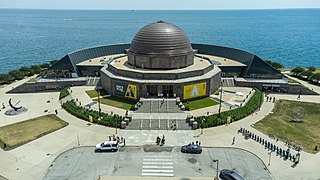
The Adler Planetarium is a public museum in Chicago, Illinois, dedicated to astronomy and astrophysics. It was founded in 1930 by local businessman Max Adler. Located on the northeastern tip of Northerly Island on Lake Michigan, the Adler Planetarium was the first planetarium in the United States. It is part of Chicago's Museum Campus, which includes the John G. Shedd Aquarium and The Field Museum. The Planetarium's mission is to inspire exploration and understanding of the universe.
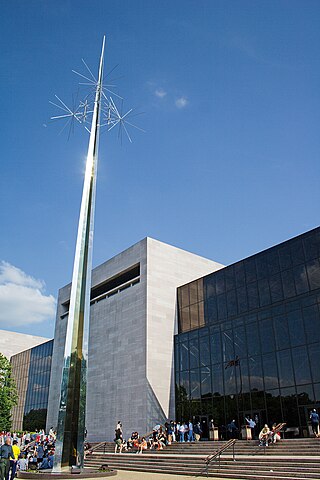
The National Air and Space Museum of the Smithsonian Institution, is a museum in Washington, D.C., in the United States dedicated to human flight and space exploration.
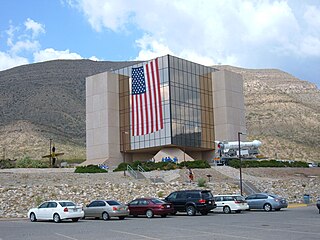
The New Mexico Museum of Space History is a museum and planetarium complex in Alamogordo, New Mexico, United States, dedicated to artifacts and displays related to space flight and the Space Age. It includes the International Space Hall of Fame. The Museum of Space History highlights the role that New Mexico has had in the U. S. space program, and is one of eight museums administered by the New Mexico Department of Cultural Affairs. The museum has been accredited by American Alliance of Museums since 1993. The museum is also a Smithsonian Affiliate.
The Oregon Museum of Science and Industry is a science and technology museum in Portland, Oregon, United States. It contains three auditoriums, including a large-screen theatre, planetarium, and exhibition halls with a variety of hands-on permanent exhibits focused on natural sciences, industry, and technology. Transient exhibits span a wider range of disciplines.

Pacific Science Center is an independent, non-profit science center in Seattle with a mission to ignite curiosity and fuel a passion for discovery, experimentation, and critical thinking. Pacific Science Center serves more than 1 million people each year at its campus adjacent to Seattle Center, at the Mercer Slough Environmental Education Center in Bellevue, Washington, and in communities and classrooms across the state of Washington.

Cosmosphere is a space museum and STEM education center in Hutchinson, Kansas, United States. It was previously known as the Kansas Cosmosphere. The museum houses over 13,000 spaceflight artifacts—the largest combined collection of US and Russian spaceflight artifacts in the world—and is home to internationally acclaimed educational programs.

The Steven F. Udvar-Hazy Center, also called the Udvar-Hazy Center, is the Smithsonian National Air and Space Museum (NASM)'s annex at Washington Dulles International Airport in the Chantilly area of Fairfax County, Virginia. It holds numerous exhibits, including the Space Shuttle Discovery, the Enola Gay, and the Boeing 367-80, the main prototype for the popular Boeing 707 airliner.

The Fernbank Science Center is a museum, classroom, and woodland complex located in Atlanta. It is owned and operated by the DeKalb County School System, which announced in May 2012 it was considering closing the facility to cut its annual budget, then quickly shelved the plan after public outcry. The nearby Fernbank Museum of Natural History is a private non-profit organization that is separate from the Science Center.

The Saint Louis Science Center, founded as a planetarium in 1963, is a collection of buildings including a science museum and planetarium in St. Louis, Missouri, on the southeastern corner of Forest Park. With over 750 exhibits in a complex of over 300,000 square feet (28,000 m2), it is among the largest of its type in the United States.

Glasgow Science Centre is a visitor attraction located in the Clyde Waterfront Regeneration area on the south bank of the River Clyde in Glasgow, Scotland. Queen Elizabeth II opened Glasgow Science Centre on 5 July 2001. It is one of Scotland's most popular paid-for visitor attractions. It is a purpose-built science centre composed of three principal buildings: Science Mall, Glasgow Tower and an IMAX cinema. It is a registered charity under Scottish law.
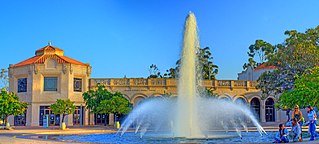
The Fleet Science Center is a science museum and planetarium in Balboa Park, located in San Diego, California. It is at the east end of the El Prado Drive walkway, next to the Bea Evenson Fountain and plaza in central Balboa Park.

Telus World of Science Edmonton (TWOSE) is a broad-based science centre in Edmonton, Alberta, Canada, operated by the (non-profit) Edmonton Space & Science Foundation. The centre is located on the southwest corner of Coronation Park in the neighborhood of Woodcroft. The science centre houses 144,430 sq. ft. of public space and is the largest science centre in Western Canada. It is currently a member of both the Association of Science-Technology Centers (ASTC) and the Canadian Association of Science Centres (CASC).

The Denver Museum of Nature & Science is a municipal natural history and science museum in Denver, Colorado. It is a resource for informal science education in the Rocky Mountain region. A variety of exhibitions, programs, and activities help museum visitors learn about the natural history of Colorado, Earth, and the universe. The 716,000-square-foot (66,519 m2) building houses more than one million objects in its collections including natural history and anthropological materials, as well as archival and library resources.

The Houston Museum of Natural Science is a natural history museum located on the northern border of Hermann Park in Houston, Texas, United States. The museum was established in 1909 by the Houston Museum and Scientific Society, an organization whose goals were to provide a free institution for the people of Houston focusing on education and science. The museum complex consists of a central facility with four floors of natural science halls and exhibits, the Burke Baker Planetarium, the Cockrell Butterfly Center, and the Wortham Giant Screen Theatre. In 2022 the museum received 1,520,000 visitors, making it seventh on the List of most-visited museums in the United States, and was the third most-visited U.S. science museum. Much of the museum's popularity is attributed to its large number of special or guest exhibits.

The Milton J. Rubenstein Museum of Science and Technology is a science and technology museum located in the Armory Square neighborhood of Downtown Syracuse, New York. The Museum includes 35,000 square feet of permanent and traveling exhibits, Science Shop, and several programs and events. The MOST is located in the former Syracuse Armory.
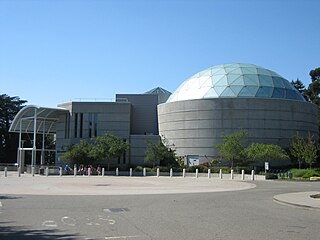
Chabot Space and Science Center, located in Oakland, California, is a center for science learning featuring interactive exhibits, planetariums, a large screen theater, hands-on activities and three powerful telescopes.

The Fort Worth Museum of Science and History is located on 1600 Gendy Street, Fort Worth, Texas 76107 in the city's Cultural District. It was opened in 1945 as the Fort Worth Children's Museum and moved to its current location in 1954. In 1968, the museum adopted its current name. Attractions at the museum include the Noble Planetarium, the Omni Theater, and the Star's Café, in addition to both traveling and permanent science and history exhibits.



















